| Oracle9i SQL Reference Release 2 (9.2) Part Number A96540-02 |
|
|
View PDF |
| Oracle9i SQL Reference Release 2 (9.2) Part Number A96540-02 |
|
|
View PDF |
Use the CREATE INDEX statement to create an index on
An index is a schema object that contains an entry for each value that appears in the indexed column(s) of the table or cluster and provides direct, fast access to rows. Oracle supports several types of index:
indextype
See Also:
|
To create an index in your own schema, one of the following conditions must be true:
INDEX object privilege on the table to be indexed.CREATE ANY INDEX system privilege.To create an index in another schema, you must have CREATE ANY INDEX system privilege. Also, the owner of the schema to contain the index must have either the UNLIMITED TABLESPACE system privilege or space quota on the tablespaces to contain the index or index partitions.
To create a domain index in your own schema, in addition to the prerequisites for creating a conventional index, you must also have EXECUTE privilege on the indextype. If you are creating a domain index in another user's schema, the index owner also must have EXECUTE privilege on the indextype and its underlying implementation type. Before creating a domain index, you should first define the indextype.
To create a function-based index in your own schema on your own table, in addition to the prerequisites for creating a conventional index, you must have the QUERY REWRITE system privilege. To create the index in another schema or on another schema's table, you must have the GLOBAL QUERY REWRITE privilege. In both cases, the table owner must also have the EXECUTE object privilege on the function(s) used in the function-based index. In addition, in order for Oracle to use function-based indexes in queries, the QUERY_REWRITE_ENABLED parameter must be set to TRUE, and the QUERY_REWRITE_INTEGRITY parameter must be set to TRUSTED.
create_index::=


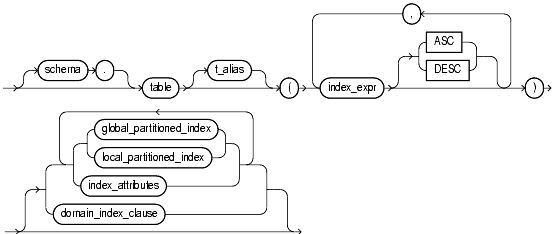
global_partitioned_index::=, local_partitioned_index::=, index_attributes::=, domain_index_clause::=)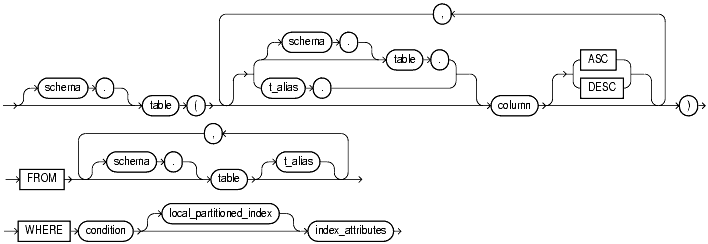
index_expr::=

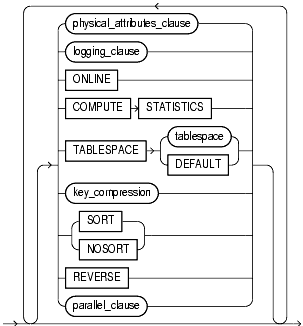
physical_attributes_clause::=
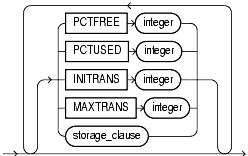
logging_clause::=

key_compression::=



index_partitioning_clause::=

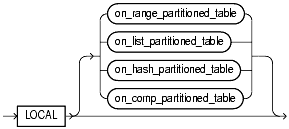
on_range_partitioned_table::=, on_list_partitioned_table::=, on_hash_partitioned_table::=, on_comp_partitioned_table::=)
on_list_partitioned_table::=

segment_attributes_clause::=



index_subpartition_clause::=

parallel_clause::=

Specify UNIQUE to indicate that the value of the column (or columns) upon which the index is based must be unique. If the index is local nonprefixed (see local_partitioned_index), then the index key must contain the partitioning key.
UNIQUE and BITMAP.UNIQUE for a domain index.
| See Also:
|
Specify BITMAP to indicate that index is to be created with a bitmap for each distinct key, rather than indexing each row separately. Bitmap indexes store the rowids associated with a key value as a bitmap. Each bit in the bitmap corresponds to a possible rowid, and if the bit is set, it means that the row with the corresponding rowid contains the key value. The internal representation of bitmaps is best suited for applications with low levels of concurrent transactions, such as data warehousing.
BITMAP when creating a global partitioned index.UNIQUE and BITMAP.BITMAP for a domain index.
See Also:
|
Specify the schema to contain the index. If you omit schema, Oracle creates the index in your own schema.
Specify the name of the index to be created.
Use the cluster_index_clause to identify the cluster for which a cluster index is to be created. If you do not qualify cluster with schema, Oracle assumes the cluster is in your current schema. You cannot create a cluster index for a hash cluster.
Specify the table (and its attributes) on which you are defining the index. If you do not qualify table with schema, Oracle assumes the table is contained in your own schema.
You create an index on a nested table column by creating the index on the nested table storage table. Include the NESTED_TABLE_ID pseudocolumn of the storage table to create a UNIQUE index, which effectively ensures that the rows of a nested table value are distinct.
table must be partitioned.REVERSE for this secondary index, and the combined size of the index key and the logical rowid should be less than half the block size.table is a temporary table, the index will also be temporary with the same scope (session or transaction) as table. The following restrictions apply to indexes on temporary table:
physical_attributes_clause or the parallel_clause.LOGGING, NOLOGGING, or TABLESPACE.
| See Also:
CREATE TABLE and Oracle9i Database Concepts for more information on temporary tables |
Specify a correlation name (alias) for the table upon which you are building the index.
|
Note: This alias is required if the |
For index_expr, specify the column or column expression upon which the index is based.
Specify the name of a column in the table. A bitmap index can have a maximum of 30 columns. Other indexes can have as many as 32 columns.
You can create an index on a scalar object attribute column or on the system-defined NESTED_TABLE_ID column of the nested table storage table. If you specify an object attribute column, the column name must be qualified with the table name. If you specify a nested table column attribute, it must be qualified with the outermost table name, the containing column name, and all intermediate attribute names leading to the nested table column attribute.
You cannot create an index on columns or attributes whose type is user-defined, LONG, LONG RAW, LOB, or REF, except that Oracle supports an index on REF type columns or attributes that have been defined with a SCOPE clause.
Specify an expression built from columns of table, constants, SQL functions, and user-defined functions. When you specify column_expression, you create a function-based index.
| See Also:
"Notes on Function-Based Indexes", "Restrictions on Function-based Indexes", and "Function-Based Index Examples" |
Name resolution of the function is based on the schema of the index creator. User-defined functions used in column_expression are fully name resolved during the CREATE INDEX operation.
After creating a function-based index, collect statistics on both the index and its base table using the ANALYZE statement. Oracle cannot use the function-based index until these statistics have been generated.
column_expression is not null. However, Oracle will use a function-based index in a query even if the columns specified in the WHERE clause are in a different order than their order in the column_expression that defined the function-based index.
DISABLED. Queries on a DISABLED index fail if the optimizer chooses to use the index. DML operations on a DISABLED index fail unless the index is also marked UNUSABLE and the parameter SKIP_UNUSABLE_INDEXES is set to true.
| See Also:
ALTER SESSION for more information on this parameter |
QUERY_REWRITE_ENABLED session parameter.
column_expression, and later an actual object with the same name is created in the table owner's schema, then Oracle will disable the function-based index. When you subsequently enable the function-based index using ALTER INDEX ... ENABLE or ALTER INDEX ... REBUILD, the function, package, or type used in the column_expression will continue to resolve to the function, package, or type to which the public synonym originally pointed. It will not resolve to the new function, package, or type.NLS_SORT and NLS_COMP). Oracle handles the conversions correctly even if these have been reset at the session level.column_expression must be DETERMINISTIC.column_expression cannot be the partitioning key.column_expression can be any form of expression except a scalar subquery expressioncolumn_expression must return a repeatable value. For example, you cannot specify the SYSDATE or USER function or the ROWNUM pseudocolumn.column_expression cannot contain any aggregate functions.Use ASC or DESC to indicate whether the index should be created in ascending or descending order. Indexes on character data are created in ascending or descending order of the character values in the database character set.
Oracle treats descending indexes as if they were function-based indexes. You do not need the QUERY REWRITE or GLOBAL QUERY REWRITE privileges to create them, as you do with other function-based indexes. However, as with other function-based indexes, Oracle does not use descending indexes until you first analyze the index and the table on which the index is defined. See the column_expression clause of this statement.
You cannot specify either of these clauses for a domain index. You cannot specify DESC for a reverse index. Oracle ignores DESC if index is bitmapped or if the COMPATIBLE initialization parameter is set to a value less than 8.1.0.
Specify the index attributes using the clauses of index_attributes.
Use the physical_attributes_clause to establish values for physical and storage characteristics for the index.
If you omit this clause, Oracle uses the following default values:
You cannot specify the PCTUSED parameter for an index.
See Also:
|
For tablespace, specify the name of the tablespace to hold the index, index partition, or index subpartition. If you omit this clause, Oracle creates the index in the default tablespace of the owner of the schema containing the index.
For a local index, you can specify the keyword DEFAULT in place of tablespace. New partitions or subpartitions added to the local index will be created in the same tablespace(s) as the corresponding partitions or subpartitions of the underlying table.
Specify COMPRESS to enable key compression, which eliminates repeated occurrence of key column values and may substantially reduce storage. Use integer to specify the prefix length (number of prefix columns to compress).
Oracle compresses only nonpartitioned indexes that are nonunique or unique indexes of at least two columns.
You cannot specify COMPRESS for a bitmap index.
Specify NOCOMPRESS to disable key compression. This is the default.
By default, Oracle sorts indexes in ascending order when it creates the index. You can specify NOSORT to indicate to Oracle that the rows are already stored in the database in ascending order, so that Oracle does not have to sort the rows when creating the index. If the rows of the indexed column or columns are not stored in ascending order, Oracle returns an error. For greatest savings of sort time and space, use this clause immediately after the initial load of rows into a table. If you specify neither of these keywords, SORT is the default.
REVERSE with this clause.Specify REVERSE to store the bytes of the index block in reverse order, excluding the rowid.
NOSORT with this clause.Specify whether the creation of the index will be logged (LOGGING) or not logged (NOLOGGING) in the redo log file. This setting also determines whether subsequent Direct Loader (SQL*Loader) and direct-path INSERT operations against the index are logged or not logged. LOGGING is the default.
If index is nonpartitioned, this clause specifies the logging attribute of the index.
If index is partitioned, this clause determines:
CREATE statement (unless you specify the logging_clause in the PARTITION description clause)ALTER TABLE ... ADD PARTITION operationsThe logging attribute of the index is independent of that of its base table.
If you omit this clause, the logging attribute is that of the tablespace in which it resides.
See Also:
|
Specify ONLINE to indicate that DML operations on the table will be allowed during creation of the index.
ONLINE and then issue parallel DML statements, Oracle returns an error.ONLINE for a bitmap index or a cluster index.ONLINE for a conventional index on a UROWID column.| See Also:
Oracle9i Database Concepts for a description of online index building and rebuilding |
Specify COMPUTE STATISTICS to collect statistics at relatively little cost during the creation of an index. These statistics are stored in the data dictionary for ongoing use by the optimizer in choosing a plan of execution for SQL statements.
The types of statistics collected depend on the type of index you are creating.
Additional methods of collecting statistics are available in PL/SQL packages and procedures.
| See Also:
Oracle9i Supplied PL/SQL Packages and Types Reference and "Computing Index Statistics: Example" |
Specify the parallel_clause if you want creation of the index to be parallelized.
Specify NOPARALLEL for serial execution. This is the default.
Specify PARALLEL if you want Oracle to select a degree of parallelism equal to the number of CPUs available on all participating instances times the value of the PARALLEL_THREADS_PER_CPU initialization parameter.
Specification of integer indicates the degree of parallelism, which is the number of parallel threads used in the parallel operation. Each parallel thread may use one or two parallel execution servers. Normally Oracle calculates the optimum degree of parallelism, so it is not necessary for you to specify integer.
Use the global_partitioned_index clause and the local_partitioned_index clauses to partition index.
|
Note: The storage of partitioned database entities in tablespaces of different block sizes is subject to several restrictions. Please refer to Oracle9i Database Administrator's Guide for a discussion of these restrictions. |
The global_partitioned_index clause lets you specify that the partitioning of the index is user defined and is not equipartitioned with the underlying table. By default, nonpartitioned indexes are global indexes. Oracle will partition the global index on the ranges of values from the table columns you specify in column_list. You cannot specify this clause for a local index.
The column_list must specify a left prefix of the index column list. That is, if the index is defined on columns a, b, and c, then for column_list you can specify (a, b, c), or (a, b), or (a, c), but you cannot specify (b, c) or (c) or (b, a).
column_list.ROWID pseudocolumn or a column of type ROWID.
| See Also:
Oracle9i Database Globalization Support Guide for more information on character set support |
Use this clause to describe the individual index partitions. The number of repetitions of this clause determines the number of partitions. If you omit partition, Oracle generates a name with the form SYS_Pn.
For VALUES LESS THAN (value_list), specify the (noninclusive) upper bound for the current partition in a global index. The value list is a comma-delimited, ordered list of literal values corresponding to the column list in the global_partitioned_index clause. Always specify MAXVALUE as the value of the last partition.
See Also:
|
The local_partitioned_index clauses let you specify that the index is partitioned on the same columns, with the same number of partitions and the same partition bounds as table. Oracle automatically maintains LOCAL index partitioning as the underlying table is repartitioned.
This clause lets you specify the names and attributes of index partitions on a range-partitioned table. If you specify this clause, then the number of PARTITION clauses must be equal to the number of table partitions, and in the same order. If you omit partition, then Oracle generates a name that is consistent with the corresponding table partition. If the name conflicts with an existing index partition name, then Oracle uses the form SYS_Pn.
The on_list_partitioned_table clause is identical to on_range_partitioned_table.
This clause lets you specify names and tablespace storage for index partitions on a hash-partitioned table.
If you specify any PARTITION clauses, then the number of these clauses must be equal to the number of table partitions. If you omit partition, then Oracle generates a name that is consistent with the corresponding table partition. If the name conflicts with an existing index partition name, then Oracle uses the form SYS_Pn. You can optionally specify tablespace storage for one or more individual partitions. If you do not specify tablespace storage either here or in the STORE IN clause, then Oracle stores each index partition in the same tablespace as the corresponding table partition.
The STORE IN clause lets you specify one or more tablespaces across which Oracle will distribute all the index hash partitions. The number of tablespaces does not have to equal the number of index partitions. If the number of index partitions is greater than the number of tablespaces, Oracle cycles through the names of the tablespaces.
This clause lets you specify the name and tablespace storage of index partitions on a composite-partitioned table.
The STORE IN clause is valid only for range-hash composite-partitioned tables. It lets you specify one or more default tablespaces across which Oracle will distribute all index hash subpartitions. You can override this storage by specifying different tablespace storage for the subpartitions of an individual partition in the second STORE IN clause in the index_subpartition_clause.
For range-list composite-partitioned tables, you can specify default tablespace storage for the list subpartitions in the PARTITION clause. You can override this storage by specifying different tablespace storage for the list subpartitions of an individual partition in the SUBPARTITION clause of the index_subpartition_clause
This clause lets you specify names and tablespace storage for index hash subpartitions in a composite-partitioned table.
The STORE IN clause is valid only for hash subpartitions of a range-hash composite-partitioned table. It lets you specify one or more tablespaces across which Oracle will distribute all the index hash subpartitions. The SUBPARTITION clause is valid for subpartitions of both range-hash and range-list composite-partitioned tables.
If you specify any SUBPARTITION clauses, then the number of those clauses must be equal to the number of table subpartitions. If you omit subpartition, then Oracle generates a name that is consistent with the corresponding table subpartition. If the name conflicts with an existing index subpartition name, then Oracle uses the form SYS_SUBPn.
The number of tablespaces does not have to equal the number of index subpartitions. If the number of index subpartitions is greater than the number of tablespaces, Oracle cycles through the names of the tablespaces.
If you do not specify tablespace storage for subpartitions either in the on_comp_partitioned_table clause or in the index_subpartition_clause, then Oracle uses the tablespace specified for index. If you also do not specify tablespace storage for index, then Oracle stores the subpartition in the same tablespace as the corresponding table subpartition.
Use the domain_index_clause to indicate that index is a domain index, which is an instance of an application-specific index of type indextype.
|
Note: Creating a domain index requires a number of preceding operations. You must first create an implementation type for an indextype. You must also create a functional implementation and then create an operator that uses the function. Next you create an indextype, which associates the implementation type with the operator. Finally, you create the domain index using this clause. Appendix D, "Examples", contains an example of a simple domain index, including all of these operations. The examples are collected in one appendix because they would be difficult to follow if scattered throughout this reference under their appropriate SQL statements. |
In the index_expr (in table_index_clause), specify the table columns or object attributes on which the index is defined. You can define multiple domain indexes on a single column only if the underlying indextypes are different and the indextypes support a disjoint set of user-defined operators.
index_expr (in table_index_clause) can specify only a single column, and the column cannot be of datatype REF, varray, nested table, LONG, or LONG RAW.For indextype, specify the name of the indextype. This name should be a valid schema object that you have already defined.
|
Note: If you have installed Oracle Text, you can use various built-in indextypes to create Oracle Text domain indexes. For more information on Oracle Text and the indexes it uses, please refer to Oracle Text Reference. |
Use the parallel_clause to parallelize creation of the domain index. For a nonpartitioned domain index, Oracle passes the explicit or default degree of parallelism to the ODCIIndexCreate cartridge routine, which in turn establishes parallelism for the index.
| See Also:
Oracle9i Data Cartridge Developer's Guide for complete information on the ODCI routines |
In the PARAMETERS clause, specify the parameter string that is passed uninterpreted to the appropriate ODCI indextype routine. The maximum length of the parameter string is 1000 characters.
When you specify this clause at the top level of the syntax, the parameters become the default parameters for the index partitions. If you specify this clause as part of the LOCAL [PARTITION] clause, you override any default parameters with parameters for the individual partition.
Once the domain index is created, Oracle invokes the appropriate ODCI routine. If the routine does not return successfully, the domain index is marked FAILED. The only operations supported on an failed domain index are DROP INDEX and (for non-local indexes) REBUILD INDEX.
| See Also:
Oracle9i Data Cartridge Developer's Guide for information on these routines |
Use the bitmap_join_index_clause to define a bitmap join index. A bitmap join index is defined on a single table. For an index key made up of dimension table columns, it stores the fact table rowids corresponding to that key. In a data warehousing environment, the table on which the index is defined is commonly referred to as a fact table, and the tables with which this table is joined are commonly referred to as dimension tables. However, a star schema is not a requirement for creating a join index.
In the ON clause, first specify the fact table, and then inside the parentheses specify the columns of the dimension tables on which the index is defined.
In the FROM clause, specify the joined tables.
In the WHERE clause, specify the join condition.
If the underlying fact table is partitioned, you must also specify one of the local_partitioned_index clauses (see local_partitioned_index).
In addition to the restrictions on bitmap indexes in general (see BITMAP), the following restrictions apply to bitmap join indexes:
FROM clause.local_index_clauses unless the fact table is partitioned.
| See Also:
Oracle9i Data Warehousing Guide for information on fact and dimension tables and on using bitmap indexes in a data warehousing environment |
The following statement shows how the sample index ord_customer_ix on the customer_id column of the sample table oe.orders was created:
CREATE INDEX ord_customer_ix ON orders (customer_id);
To create the ord_customer_ix index with the COMPRESS clause, you might issue the following statement:
CREATE INDEX ord_customer_ix_demo ON orders (customer_id, sales_rep_id) COMPRESS 1;
The index will compress repeated occurrences of customer_id column values.
The following statement collects statistics on the ord_customer_ix_demo index during its creation:
CREATE INDEX ord_customer_ix_demo ON orders(customer_id, sales_rep_id) COMPUTE STATISTICS;
The type of statistics collected depends on the type of index you are creating.
If the sample table orders had been created using a fast parallel load (so all rows were already sorted), you could issue the following statement to quickly create an index.
/* Unless you first sort the table oe.orders, this example fails because you cannot specify NOSORT unless the base table is already sorted. */ CREATE INDEX ord_customer_ix_demo ON orders (order_mode) NOSORT NOLOGGING;
To create an index for the personnel cluster, which was created in "Creating a Cluster: Example", issue the following statement:
CREATE INDEX idx_personnel ON CLUSTER personnel;
No index columns are specified, because the index is automatically built on all the columns of the cluster key. For cluster indexes, all rows are indexed.
The following example creates an index on the area element of the xwarehouses table (created in "XMLType Table Examples"):
CREATE INDEX area_index ON xwarehouses e (EXTRACTVALUE(VALUE(e),'/Warehouse/Area'));
Such an index would greatly improve the performance of queries that select from the table based on, for example, the square footage of a warehouse, as shown in this statement:
SELECT e.getClobVal() AS warehouse FROM xwarehouses e WHERE EXISTSNODE(VALUE(e),'/Warehouse[Area>50000]') = 1;
| See Also:
EXISTSNODE and VALUE |
The following statement creates a function-based index on the employees table based on an uppercase evaluation of the last_name column:
CREATE INDEX upper_ix ON employees (UPPER(last_name));
See the "Prerequisites" for the privileges and parameter settings required when creating function-based indexes.
To ensure that Oracle will use the index rather than performing a full table scan, be sure that the value of the function is not null in subsequent queries. For example, this statement is guaranteed to use the index:
SELECT first_name, last_name FROM employees WHERE UPPER(last_name) IS NOT NULL ORDER BY UPPER(last_name);
However, without the WHERE clause, Oracle may perform a full table scan.
In the next statements showing index creation and subsequent query, Oracle will use index income_ix even though the columns are in reverse order in the query:
CREATE INDEX income_ix ON employees(salary + (salary*commission_pct)); SELECT first_name||' '||last_name "Name" FROM employees WHERE (salary*commission_pct) + salary > 15000;
The following statement uses the function created in "Using a Packaged Procedure in a Function: Example" to create a function-based index on a LOB column in the sample pm schema. The example then collects statistics on the function-based index and selects rows from the sample table print_media where that CLOB column has fewer than 1000 characters.
CREATE INDEX src_idx ON print_media(text_length(ad_sourcetext)); ANALYZE INDEX src_idx COMPUTE STATISTICS; SELECT product_id FROM print_media WHERE text_length(ad_sourcetext) < 1000; PRODUCT_ID ---------- 3060 2056 3106 2268
This example entails an object type rectangle containing two number attributes: length and width. The area() method computes the area of the rectangle.
CREATE TYPE rectangle AS OBJECT ( length NUMBER, width NUMBER, MEMBER FUNCTION area RETURN NUMBER DETERMINISTIC ); CREATE OR REPLACE TYPE BODY rectangle AS MEMBER FUNCTION area RETURN NUMBER IS BEGIN RETURN (length*width); END; END;
Now, if you create a table rect_tab of type rectangle, you can create a function-based index on the area() method as follows:
CREATE TABLE rect_tab OF rectangle; CREATE INDEX area_idx ON rect_tab x (x.area());
You can use this index efficiently to evaluate a query of the form:
SELECT * FROM rect_tab x WHERE x.area() > 100;
The following statement creates a global prefixed index amount_sold on the sample table sh.sales with three partitions that divide the range of costs into three groups:
CREATE INDEX cost_ix ON sales (amount_sold) GLOBAL PARTITION BY RANGE (amount_sold) (PARTITION p1 VALUES LESS THAN (1000), PARTITION p2 VALUES LESS THAN (2500), PARTITION p3 VALUES LESS THAN (MAXVALUE));
The following statement creates a local index on the product_id column of the product_information_part partitioned table (which was created in"Hash Partitioning Example") . The STORE IN clause immediately following LOCAL indicates that product_information_part is hash partitioned. Oracle will distribute the hash partitions between the tbs1 and tbs2 tablespaces:
CREATE INDEX prod_idx ON product_information_part(product_id) LOCAL STORE IN (tbs_1, tbs_2);
|
Note: The creator of the index needs quote on the tablespaces specified. See CREATE TABLESPACE for the examples that created these tablespaces. |
The following statement creates a local index on the composite_sales table, which was created in "Composite-Partitioned Table Examples". The STORAGE clause specifies default storage attributes for the index. However, this default is overridden for the five subpartitions of partitions q3_2000 and q4_2000, because separate TABLESPACE storage is specified.
|
Note: The creator of the index must have quota on the tablespaces specified. See CREATE TABLESPACE for the creation of tablespaces |
CREATE INDEX sales_ix ON composite_sales(time_id, prod_id) STORAGE (INITIAL 1M MAXEXTENTS UNLIMITED) LOCAL (PARTITION q1_1998, PARTITION q2_1998, PARTITION q3_1998, PARTITION q4_1998, PARTITION q1_1999, PARTITION q2_1999, PARTITION q3_1999, PARTITION q4_1999, PARTITION q1_2000, PARTITION q2_2000 (SUBPARTITION pq2001, SUBPARTITION pq2002, SUBPARTITION pq2003, SUBPARTITION pq2004, SUBPARTITION pq2005, SUBPARTITION pq2006, SUBPARTITION pq2007, SUBPARTITION pq2008), PARTITION q3_2000 (SUBPARTITION c1 TABLESPACE tbs_1, SUBPARTITION c2 TABLESPACE tbs_1, SUBPARTITION c3 TABLESPACE tbs_1, SUBPARTITION c4 TABLESPACE tbs_1, SUBPARTITION c5 TABLESPACE tbs_1), PARTITION q4_2000 (SUBPARTITION pq4001 TABLESPACE tbs_2, SUBPARTITION pq4002 TABLESPACE tbs_2, SUBPARTITION pq4003 TABLESPACE tbs_2, SUBPARTITION pq4004 TABLESPACE tbs_2) );
The following creates a bitmap join index on the table oe.product_information_part, which was created in "Hash Partitioning Example":
CREATE BITMAP INDEX product_bm_ix ON product_information_part(list_price) TABLESPACE tbs_1 LOCAL(PARTITION ix_p1 TABLESPACE tbs_2, PARTITION ix_p2, PARTITION ix_p3 TABLESPACE tbs_3, PARTITION ix_p4, PARTITION ix_p5 TABLESPACE tbs_4 );
Because product_information_part is a partitioned table, the bitmap join index must be locally partitioned.
|
Note: In this example, the user must have quota on tablespaces specified. See CREATE TABLESPACE for examples that create tablespaces |
The sample table pm.print_media contains a nested table column ad_textdocs_ntab, which is stored in storage table textdocs_nestedtab. The following example creates a unique index on storage table textdocs_nestedtab:
CREATE UNIQUE INDEX nested_tab_ix ON textdocs_nestedtab(NESTED_TABLE_ID, document_typ);
Including pseudocolumn NESTED_TABLE_ID ensures distinct rows in nested table column ad_textdocs_ntab.
You can build an index on attributes of the declared type of a substitutable column. In addition, you can reference the subtype attributes by using the appropriate TREAT function. The following example uses the table books, which is created in "Substitutable Table and Column Examples". The statement creates an index on the salary attribute of all employee authors in the books table:
CREATE INDEX salary_i ON books (TREAT(author AS employee_t).salary);
The target type in the argument of the TREAT function must be the type that added the attribute being referenced. In the example, the target of TREAT is employee_t, which is the type that added the salary attribute.
If this condition is not satisfied, Oracle interprets the TREAT function as any functional expression and creates the index as a function-based index. For example, the following statement creates a function-based index on the salary attribute of part-time employees, assigning nulls to instances of all other types in the type hierarchy.
CREATE INDEX salary_func_i ON persons p (TREAT(VALUE(P) AS part_time_emp_t).salary);
You can also build an index on the type-discriminant column underlying a substitutable column by using the SYS_TYPEID function.
The following statement creates a bitmap index on the typeid of the author column of the books table:
CREATE BITMAP INDEX typeid_i ON books (SYS_TYPEID(author));
See Also:
|